U.S. Military Enlisted and Officer Rank Insignia
Background
In the U.S. Military services, rank determines who gets to tell whom what to do. The higher one's rank, the more authority (and responsibility) they have. U.S. Military personnel fall into one of three categories: (1) enlisted members, (2) warrant officers, and (3) commissioned officers. Warrant officers outrank all enlisted members, and commissioned officers outrank all warrant officers and enlisted members.
"Rank" and "pay grade" are closely associated terms, but not quite the same. "Pay grade" is an administrative classification, associated with a member's pay. "Rank" is a title and denotes the member's level of authority and responsibility. An E-1 is the lowest enlisted pay grade. That person's "rank" is a "Private" in the Army and Marine Corps, an "Airman Basic" in the Air Force, and a "Seaman Recruit" in the Navy and Coast Guard. In the Navy and Coast Guard, the term "rank" is not used among enlisted Sailors. The proper term is "rate."
Enlisted Rank Insignia of the U.S. Armed Forces
Service members in paygrades E-1 through E-3 are usually either in some kind of training status or on their initial assignment. The training includes the basic training phase where recruits are immersed in military culture and values and are taught the core skills required by their service component.
Basic training is followed by a specialized or advanced training phase that provides recruits with a specific area of expertise or concentration. In the Army and Marine Corps, this area is called a military occupational specialty; in the Navy it is known as a rate; and in the Air Force it is simply called an Air Force specialty.
E-1

Army
Private E-1
(PV1)

Marines
Private
(Pvt)

Air Force
Airman Basic
(AB)

Navy
Seaman Recruit
(SR)

Coast Guard
Seaman Recruit
(SR)
E-2
Army
Private E-2
(PV2)

Marines
Private First Class
(PFC)

Air Force
Airman
(Amn)

Navy
Seaman Apprentice
(SA)

Coast Guard
Seaman Apprentice
(SA)

E-3
Army
Private First Class
(PFC)

Marines
Lance Corporal
(LCpl)

Air Force
Airman First Class
(A1C)

Navy
Seaman
(SN)

Coast Guard
Seaman
(SN)

E-4
Army
Corporal
(CPL)

Specialist
(SPC)

Marines
Corporal
(Cpl)

Air Force
Senior Airman
(SrA)

Navy
Petty Officer Third Class
(PO3)

Coast Guard
Petty Officer Third Class
(PO3)

Leadership responsibility significantly increases in the midlevel enlisted ranks. This responsibility is given formal recognition by use of the terms noncommissioned officer and petty officer. An Army sergeant, an Air Force staff sergeant and a Marine corporal are considered NCO ranks. The Navy NCO equivalent, petty officer, is achieved at the rank of petty officer third class.
E-5
Army
Sergeant
(SGT)

Marines
Sergeant
(Sgt)

Air Force
Staff Sergeant
(SSgt)

Navy
Petty Officer Second Class
(PO2)

Coast Guard
Petty Officer Second Class
(PO2)

E-6
Army
Staff Sergeant
(SSG)

Marines
Staff Sergeant
(SSgt)

Air Force
Technical Sergeant
(TSgt)

Navy
Petty Officer First Class
(PO1)

Coast Guard
Petty Officer First Class
(PO1)

E-7
Army
Sergeant First Class
(SFC)
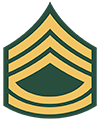
Marines
Gunnery Sergeant
(GySgt)

Air Force
Master Sergeant
(MSgt)

First Sergeant

Navy
Chief Petty Officer
(CPO)

Coast Guard
Chief Petty Officer
(CPO)

At the E-8 level, the Army, Marine Corps and Air Force have two positions at the same paygrade. Whether one is, for example, a senior master sergeant or a first sergeant in the Air Force depends on the person's job.
The same is true for the positions at the E-9 level. Marine Corps master gunnery sergeants and sergeants major receive the same pay but have different responsibilities. All told, E-8s and E-9s have 15 to 30 years on the job, and are commanders' senior advisers for enlisted matters.
A third E-9 element is the senior enlisted person of each service. The sergeant major of the Army, the sergeant major of the Marine Corps, the master chief petty officer of the Navy and the chief master sergeant of the Air Force are the spokespersons of the enlisted force at the highest levels of their services.
E-8
Army
Master Sergeant
(MSG)

First Sergeant
(1SG)

Marines
Master Sergeant
(MSgt)

First Sergeant

Air Force
Senior Master Sergeant
(SMSgt)
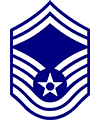
First Sergeant

Navy
Senior Chief Petty Officer
(SCPO)

Coast Guard
Senior Chief Petty Officer
(SCPO)

E-9
Army
Sergeant Major
(SGM)

Command Sergeant Major
(CSM)

Marines
Master Gunnery Sergeant
(MGySgt)
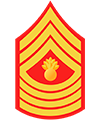
Sergeant Major
(SgtMaj)

Air Force
Chief Master Sergeant
(CMSgt)

First Sergeant
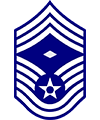
Command Chief Master Sergeant

Navy
Master Chief Petty Officer
(MCPO)

Fleet/Command Master Chief Petty Officer
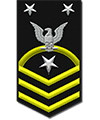
Coast Guard
Master Chief Petty Officer
(MCPO)

Fleet/Command Master Chief Petty Officer

E-9 Senior Enlisted
Army
Sergeant Major of the Army
(SMA)

Marines
Sergeant Major of the Marine Corps
(SgtMajMC)

Air Force
Chief Master Sergeant of the Air Force
(CMSAF)

Navy
Master Chief Petty Officer of the Navy
(MCPON)
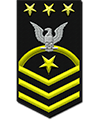
Coast Guard
Master Chief Petty Officer of the Coast Guard
(MCPOCG)
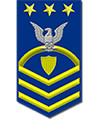
Additional Rank info
Ensigns started with the Army but ended with the Navy. The rank of Army ensign was long gone by the time the rank of Navy ensign was established in 1862. Ensigns received gold bars in 1922, some five years after equivalent Army second lieutenants received theirs.
"Lieutenant" comes from the French "lieu" meaning "place" and "tenant" meaning "holding." Literally, lieutenants are placeholders. The British originally corrupted the French pronunciation, pronouncing the word, "lieuftenant," while Americans (probably because of French settler influence) maintained the original pronunciation.
While majors outrank lieutenants, lieutenant generals outrank major generals. This comes from British tradition: Generals were appointed for campaigns and often called "captain generals." Their assistants were, naturally, "lieutenant generals." At the same time, the chief administrative officer was the "sergeant major general." Somewhere along the way, "sergeant" was dropped.
Gold is worth more than silver, but silver outranks gold. This is because the Army decreed in 1832 that infantry colonels would wear gold eagles on an epaulet of silver, and all other colonels would wear silver eagles on gold. When majors and lieutenant colonels received the leaves, this tradition would not continue. So silver leaves represented lieutenant colonels and gold, majors. The case of lieutenants is different: First lieutenants had been wearing silver bars for 80 years before second lieutenants had any bars at all.
Colonel is pronounced "kernal" because the British adopted the French spelling "colonel," but Spanish pronunciation "coronel", and then corrupted the pronunciation.
While rank insignia is important, sometimes it isn't smart to wear them. When the rifled musket made its appearance in the Civil War, sharpshooters looked for officers. Officers soon learned to take off their rank insignia as they approached the battle line.
The Air Force actually took a vote on their enlisted stripes. In 1948, then-Air Force Vice Chief of Staff Gen. Hoyt Vandenberg polled NCOs at Bolling Air Force Base in Washington, and 55 percent of them chose the basic design still used today. When the Air Force became a separate service in 1947, it kept the Army officer insignia and names, but adopted different enlisted ranks and insignia.
Officer Insignia
The commissioned ranks are the highest in the military. These officers hold presidential commissions and are confirmed at their ranks by the Senate. Army, Air Force and Marine Corps officers are called company grade officers in the paygrades of O-1 to O-3, field grade officers in paygrades O-4 to O-6 and general officers in paygrades O-7 and higher. The equivalent officer groupings in the Navy are called junior grade, mid-grade and flag.
Naval officers wear distinctively different rank devices depending upon the uniform they're wearing. The three basic uniforms and rank devices used are: khakis, collar insignia pins; whites, stripes on shoulder boards; and blues, stripes sewn on the lower coat sleeves.
O-1 Officers
Army
Second Lieutenant
(2LT)

Marines
Second Lieutenant
(2ndLt)

Air Force
Second Lieutenant
(2d Lt)

Navy
Ensign
(ENS)

Coast Guard
Ensign
(ENS)

O-2 Officers
Army
First Lieutenant
(1LT)

Marines
First Lieutenant
(1stLt)

Air Force
First Lieutenant
(1st Lt)

Navy
Lieutenant Junior Grade
(LTJG)

Coast Guard
Lieutenant Junior Grade
(LTJG)

O-3 Officers
Army
Captain
(CPT)

Marines
Captain
(Capt)

Air Force
Captain
(Capt)

Navy
Lieutenant
(LT)

Coast Guard
Lieutenant
(LT)

O-4 Officers
Army
Major
(MAJ)

Marines
Major
(Maj)

Air Force
Major
(Maj)

Navy
Lieutenant Commander
(LCDR)

Coast Guard
Lieutenant Commander
(LCDR)

O-5 Officers
Army
Lieutenant Colonel
(LTC)

Marines
Lieutenant Colonel
(LtCol)

Air Force
Lieutenant Colonel
(Lt Col)

Navy
Commander
(CDR)

Coast Guard
Commander
(CDR)

O-6 Officers
Army
Colonel
(COL)

Marines
Colonel
(Col)

Air Force
Colonel
(Col)

Navy
Captain
(CAPT)
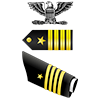
Coast Guard
Captain
(CAPT)

O-7 Officers
Army
Brigadier General
(BG)

Marines
Brigadier General
(BGen)

Air Force
Brigadier General
(Brig Gen)

Navy
Rear Admiral Lower Half
(RDML)

Coast Guard
Rear Admiral Lower Half
(RDML)

O-8 Officers
Army
Major General
(MG)

Marines
Major General
(MajGen)

Air Force
Major General
(Maj Gen)

Navy
Rear Admiral Upper Half
(RADM)

Coast Guard
Rear Admiral Upper Half
(RADM)
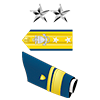
O-9 Officers
Army
Lieutenant General
(LTG)

Marines
Lieutenant General
(LtGen)

Air Force
Lieutenant General
(Lt Gen)

Navy
Vice Admiral
(VADM)

Coast Guard
Vice Admiral
(VADM)

O-10 Officers
Army
General
(GEN)

Marines
General
(Gen)

Air Force
General
(Gen)

Navy
Admiral
(ADM)
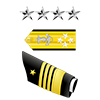
Coast Guard
Admiral
(ADM)

Special
Army
General of the Army
(Reserved for wartime only)

Marines
N/A
Air Force
General of the Air Force
(Reserved for wartime only)

Navy
Fleet Admiral
(Reserved for wartime only)

Coast Guard
Fleet Admiral
(Reserved for wartime only)

Warrant Officers
Warrant officers hold warrants from their service secretary and are specialists and experts in certain military technologies or capabilities. The lowest-ranking warrant officers serve under a warrant, but they receive commissions from the president upon promotion to chief warrant officer 2. These commissioned warrant officers are direct representatives of the president of the United States. They derive their authority from the same source as commissioned officers but remain specialists, in contrast to commissioned officers, who are generalists. There are no warrant officers in the Air Force.
W-1 Officers
Army
Warrant Officer 1
(WO1)

Marines
Warrant Officer 1
(WO)

Air Force
N/A
Navy
USN Warrant Officer 1
(WO1)

Coast Guard
N/A
W-2 Officers
Army
Chief Warrant Officer 2
(CW2)

Marines
Chief Warrant Officer 2
(CWO2)

Air Force
N/A
Navy
USN Chief Warrant Officer 2
(CWO2)

Coast Guard
Chief Warrant Officer 2
(CWO2)

W-3 Officers
Army
Chief Warrant Officer 3
(CW3)

Marines
Chief Warrant Officer 3
(CWO3)

Air Force
N/A
Navy
USN Chief Warrant Officer 3
(CWO3)

Coast Guard
Chief Warrant Officer 3
(CWO3)

W-4 Officers
Army
Chief Warrant Officer 4
(CW4)

Marines
Chief Warrant Officer 4
(CWO4)

Air Force
N/A
Navy
USN Chief Warrant Officer 4
(CWO4)

Coast Guard
Chief Warrant Officer 4
(CWO4)

W-5 Officers
Army
Chief Warrant Officer 5
(CW5)

Marines
Chief Warrant Officer 5
(CWO5)

Air Force
N/A
Navy
USN Chief Warrant Officer 5
(CWO5)

Coast Guard
N/A
Information for this page obtained from: